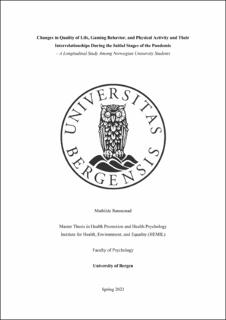Changes in Quality of Life, Gaming Behavior, and Physical Activity and Their Interrelationships During the Initial Stages of the Pandemic – A Longitudinal Study Among Norwegian University Students
Master thesis
Permanent lenke
https://hdl.handle.net/11250/3069991Utgivelsesdato
2023-05-15Metadata
Vis full innførselSamlinger
- Master theses [157]
Sammendrag
There is limited knowledge about longitudinal trends and the interrelations between problematic gaming, physical activity, and quality of life among university students during the Covid-19 pandemic. As society was faced with unprecedented social restrictions, these aspects may have developed in an unfavorable manner, which is important to address from a public health perspective. To contribute essential knowledge regarding the development of problematic gaming, physical activity, and quality of life in the initial stages of the pandemic among Norwegian students and their temporal interrelations. This thesis derives from the ‘Students’ Psychological Health Over Time’ study – a joint effort from the Norwegian Institute of Public Health and the University of Bergen. Linear mixed methods examined the development from January 2020 to November 2020 and gender differences. Cross-lagged analyses obtained the temporal interrelations across time and assessed gender differences within these. The sample exhibited decreased physical activity and quality of life over time. Men reported reduced problematic gaming. There were mutual negative temporal associations between physical activity and problematic gaming. There was a negative association between problematic gaming at t – 1 and quality of life at t. This association lost statistical significance after adjusting for covariates age, gender, socioeconomic status, and partner status. Quality of life was a stronger association for later problematic gaming behavior in men than women. The findings highlight negative development in physical activity and quality of life, some gender differences, and temporal interrelations in the initial phases of the pandemic. These changes must be accounted for when implementing measures to facilitate healthy development in university students.
